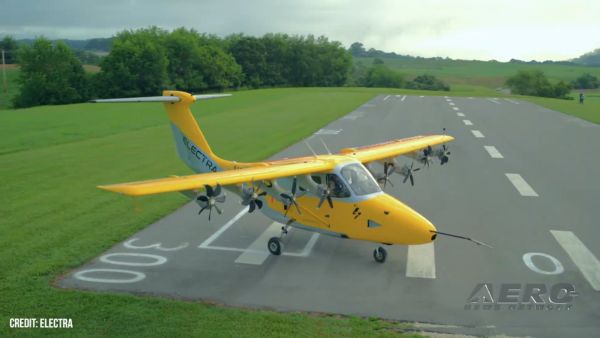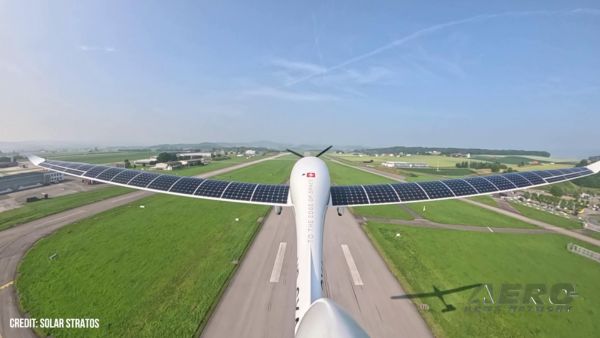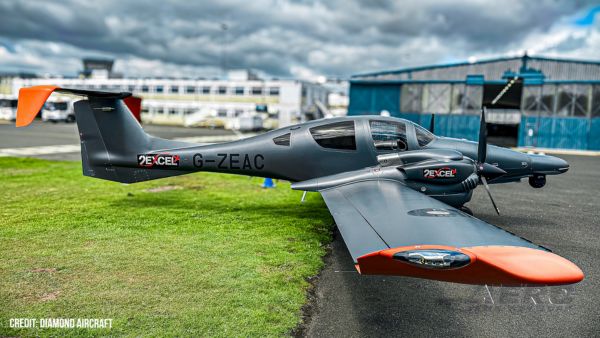Strange Problems Kept Bruce Bohannon From Records at
Oshkosh
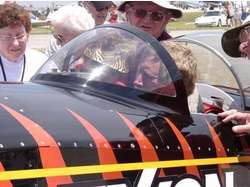 "It was a vibration that plagued us from the day
we turbo-charged the airplane", said Bruce Bohannon, already the
holder of world time-to-climb and altitude records. "The
shaking was so bad that it cracked the turbo mounts and nothing we
tried could stop it." The phantom vibration that haunted the
Exxon Flyin' Tiger cost Bohannon 3 more World Records at
Airventure 2002. "Our sponsors and fans should have seen
a World Record flight, not a test flight," said Bruce.
"It was a vibration that plagued us from the day
we turbo-charged the airplane", said Bruce Bohannon, already the
holder of world time-to-climb and altitude records. "The
shaking was so bad that it cracked the turbo mounts and nothing we
tried could stop it." The phantom vibration that haunted the
Exxon Flyin' Tiger cost Bohannon 3 more World Records at
Airventure 2002. "Our sponsors and fans should have seen
a World Record flight, not a test flight," said Bruce.
Bohannon planned to establish a brand new record for piston
engine aircraft, "Time to Climb to 12,000 Meters" (just under
40,000 feet). With the power of the Mattituck IO-555
engine and the new turbo, designed & built by Kelly
Aerospace, he also planned to break his own records for "Absolute
Altitude" (in class), and for "Altitude in Horizontal Flight." But
there was a gremlin in the installation; one that first reared its
head at Sun 'n Fun in April and finally cornered Team Tiger at
Oshkosh. "We had some theories about what was causing the
vibration," says Bruce, "but we hadn't figured out how to cure
it."
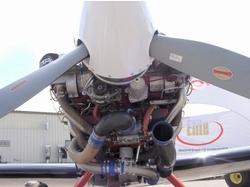 The Exxon Flyin' Tiger set a new record
for Absolute Altitude (class c-1.b) at Sun 'n Fun, reaching 37,552
feet. During the climb, Bohannon had trouble -- the engine ran
a little roughly. "I thought that I was getting lost in the leaning
process as I closed the wastegate on the turbo," says Bruce. "It
wasn't until we got home that I discovered that the pressurization
line to the rail that feeds air to one side of the engine (3
cylinders) had come loose." The resulting air-fuel mixture
imbalance explained the engine roughness; but nothing explained
that infernal vibration that jarred it loose.
The Exxon Flyin' Tiger set a new record
for Absolute Altitude (class c-1.b) at Sun 'n Fun, reaching 37,552
feet. During the climb, Bohannon had trouble -- the engine ran
a little roughly. "I thought that I was getting lost in the leaning
process as I closed the wastegate on the turbo," says Bruce. "It
wasn't until we got home that I discovered that the pressurization
line to the rail that feeds air to one side of the engine (3
cylinders) had come loose." The resulting air-fuel mixture
imbalance explained the engine roughness; but nothing explained
that infernal vibration that jarred it loose.
Still, Team Tiger had bigger fish to fry. Cooling had become a
major problem since the turbo installation. CHTs were running high
during the climb, and Bohannon had his sights set on a "triple
play" at Oshkosh. So, after fixing the pressure line, all attention
turned to engine cooling. With AirVenture just 3 months away, the
crew launched a marathon mission.
Hours of research & development, testing and modifications
paid off. Engine cooling was greatly improved and Bohannon was
confident he could bag the three records. "I was about to learn my
lesson the hard way," he said. "We had the power, we had the
cooling but we hadn't made a test flight to altitude." With little
time remaining, Team Tiger left for Oshkosh with all-new turbo
mounts -- but without a test flight.
July 27th, Oshkosh, Wisconsin: Fooie.
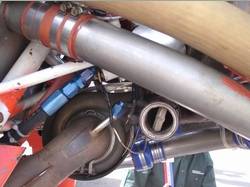 Black clouds that postponed Saturday's scheduled
record attempt soon revealed a silver lining. "The weather delay
bought me time to consult an expert on our mystery vibration", says
Bruce. "That's the great thing about Oshkosh, so many bright minds
in one place, willing to help." Bohannon asked turbo guru Bob
Minnis of Avpower for his advice. "It took us 10 minutes to remove
the cowling, it took Bob 10 seconds to spot the problem", says
Bohannon. The culprit? The line that pressurized the fuel injector
nozzles was installed in a low-pressure area. Inadequate
pressurization was causing a fuel mixture problem that didn't raise
red flags on the EGTs. Crewmembers moved the line to a slightly
higher-pressure area pointed out by Minnis. "Bob also pointed out
that the line was too small to pressurize the fuel pump, the mags
and the fuel injector nozzles", says Bruce. "We were trying
to feed three accessories with one pressure line that was too small
for even one of them!"
Black clouds that postponed Saturday's scheduled
record attempt soon revealed a silver lining. "The weather delay
bought me time to consult an expert on our mystery vibration", says
Bruce. "That's the great thing about Oshkosh, so many bright minds
in one place, willing to help." Bohannon asked turbo guru Bob
Minnis of Avpower for his advice. "It took us 10 minutes to remove
the cowling, it took Bob 10 seconds to spot the problem", says
Bohannon. The culprit? The line that pressurized the fuel injector
nozzles was installed in a low-pressure area. Inadequate
pressurization was causing a fuel mixture problem that didn't raise
red flags on the EGTs. Crewmembers moved the line to a slightly
higher-pressure area pointed out by Minnis. "Bob also pointed out
that the line was too small to pressurize the fuel pump, the mags
and the fuel injector nozzles", says Bruce. "We were trying
to feed three accessories with one pressure line that was too small
for even one of them!"
July 28th: Ready as Ever.
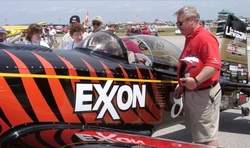 Sunday dawned with cautious optimism. With the
patch in place, The Exxon Flyin' Tiger was "race ready" and
Bohannon departed on schedule. Crew Chief Gary Hunter (seen
holding helmet at SNF 2002, right) monitored Bruce's progress as he
headed for 40,000 feet. The vibration was gone and the engine was
running smoother, but at 27,500 feet the good times ended. There
was a sudden, drastic loss of manifold pressure. The engine ran
fine by itself but Bohannon couldn't get the turbo to spool back
up. He says, "My first thought was that I had blown off a pipe
ahead of the firewall. I was disappointed but felt sure it was a
simple fix and we'd be right back in action."
Sunday dawned with cautious optimism. With the
patch in place, The Exxon Flyin' Tiger was "race ready" and
Bohannon departed on schedule. Crew Chief Gary Hunter (seen
holding helmet at SNF 2002, right) monitored Bruce's progress as he
headed for 40,000 feet. The vibration was gone and the engine was
running smoother, but at 27,500 feet the good times ended. There
was a sudden, drastic loss of manifold pressure. The engine ran
fine by itself but Bohannon couldn't get the turbo to spool back
up. He says, "My first thought was that I had blown off a pipe
ahead of the firewall. I was disappointed but felt sure it was a
simple fix and we'd be right back in action."
Hours later, there were no obvious answers. Team Tiger went over
every inch under the cowling but found nothing wrong. "At this
point, I suspected the pop-off valve on the turbo may have stuck
open", says Bruce. "It was the only way I could see losing that
much pressure that fast without breaking a pipe." The pop-off valve
appeared to function correctly on inspection. With only one day of
AirVenture left, Bohannon decided to wire it shut (just in case)
and make another run.
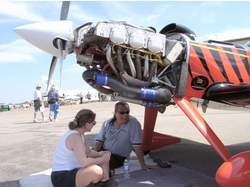 Bruce told ANN at the time that, because of the
action of the engine, he thought it was a stuck wastegate; but
there was nothing he could find on the ground to bear that out.
Last week, he told us, "The pop-off valve for sure did not fail.
There's absolutely nothing wrong with it." That confused him at
Oshkosh, too: "It was so fluid, so easy to push. Why it popped
(Saturday) makes no sense." He still doesn't think there's any
problem with the turbo and its wastegate. "We're not going to
change a thing, until after we can duplicate the problem," he
said.
Bruce told ANN at the time that, because of the
action of the engine, he thought it was a stuck wastegate; but
there was nothing he could find on the ground to bear that out.
Last week, he told us, "The pop-off valve for sure did not fail.
There's absolutely nothing wrong with it." That confused him at
Oshkosh, too: "It was so fluid, so easy to push. Why it popped
(Saturday) makes no sense." He still doesn't think there's any
problem with the turbo and its wastegate. "We're not going to
change a thing, until after we can duplicate the problem," he
said.
The turbo, while essential to the record, really isn't stressed
that hard. Ralph Benway, one of the engineers on the turbo team at
Kelley Aerospace, told ANN at Sun 'n Fun, "Considering he went to
35,000 feet naturally aspirated, he really doesn't need that
much boost. He would need a lot more, if he were trying for
full power at 40,000 feet; but he just wants to fly there."
July 29th: Ready as it's gonna be.
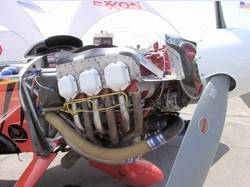 Monday's record attempt brought no joy for Team
Tiger. The airplane started struggling at 25,500 feet, and by
30,000' Bohannon knew there was no record in the cards. "As with
most test flights, we landed with more questions than answers",
said Bruce. "The folks at Kelly Aerospace have since done tests and
ruled out any physical problems with the turbo and the pressure
relief valve. Now they're working some real scientific questions
involving possible phantom airflow problems."
Monday's record attempt brought no joy for Team
Tiger. The airplane started struggling at 25,500 feet, and by
30,000' Bohannon knew there was no record in the cards. "As with
most test flights, we landed with more questions than answers",
said Bruce. "The folks at Kelly Aerospace have since done tests and
ruled out any physical problems with the turbo and the pressure
relief valve. Now they're working some real scientific questions
involving possible phantom airflow problems."
When we talked with the tall altitude-hound, he called the
manifestation a "strange vibration." He said, "We've got ideas of
what it could be; but we don't want to speculate." Bohannon notes
that complications are par for the course. "When you take a
one-of-a-kind airplane and mate it with a one-of-a-kind
turbocharger then try to go places piston engine planes don't
normally go, it gets hairy. That's what experimental aviation is
all about; learning to do what hasn't been done before."
He wanted to go home, and sort the machine out. As Donah,
Bruce's wife and (as Bruce says), "the brains of the operation,"
told ANN, "It's much easier to do troubleshooting at home
base."
Lessons learned at Oshkosh are already being applied back at
Flyin' Tiger Field in Texas. Bohannon says, "We have some fuel-air
mixture issues to address, starting with the improvements
recommended by Bob Minnis." High-altitude flight requires
pressurization of the magnetos, fuel pump and fuel injector
nozzles. Minnis pointed out that the pressurization lines on The
Exxon Flyin' Tiger were too small. Team Tiger is replacing them
with larger lines supplying individual service to each
accessory.
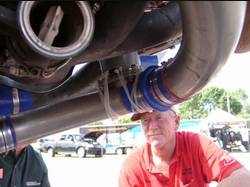 Bruce told us that, "What we really needed was
three more weeks between Sun 'n Fun and Oshkosh." EAA: are you
listening?
Bruce told us that, "What we really needed was
three more weeks between Sun 'n Fun and Oshkosh." EAA: are you
listening?
"We never intended to make a public test flight", says Bruce.
"We have a lot of work on our desk, but when we do set another
record date, we'll have already proven we can do it… several
times!"
Bruce took the non-records philosophically. He had, after all,
not broken anything.
"The good news is," he said, "there's a complete airplne to fly
home in." The "Never Say Die" team has spoken.
 NTSB Final Report: Stinson 108
NTSB Final Report: Stinson 108 ANN's Daily Aero-Linx (08.17.25)
ANN's Daily Aero-Linx (08.17.25) Aero-News: Quote of the Day (08.17.25)
Aero-News: Quote of the Day (08.17.25) ANN's Daily Aero-Term (08.17.25): Outer Fix
ANN's Daily Aero-Term (08.17.25): Outer Fix Airborne Affordable Flyers 08.14.25: Affordable Flying Expo, RV15 Kit, Spirit V2
Airborne Affordable Flyers 08.14.25: Affordable Flying Expo, RV15 Kit, Spirit V2







